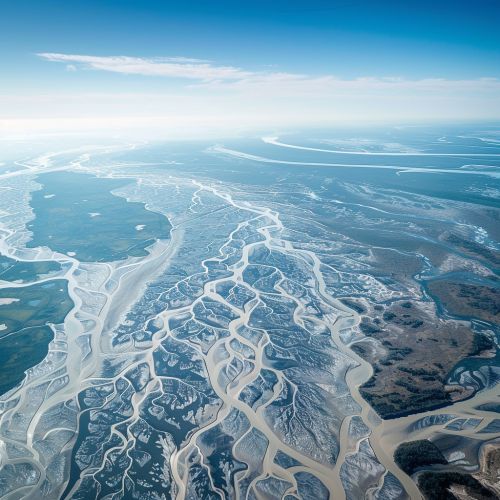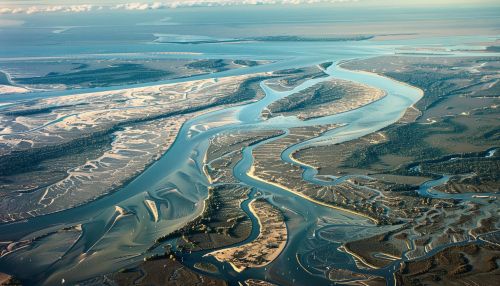River delta
Formation
A river delta is a landform that forms from deposition of sediment that is carried by a river as the flow leaves its mouth and enters slower-moving or stagnant water. This occurs where a river enters an ocean, sea, estuary, lake, reservoir, or (more rarely) another river that cannot carry away the supplied sediment. The size and shape of a delta is controlled by the balance between watershed processes that supply sediment, and receiving basin processes that redistribute, sequester, and export that sediment. The size, geometry, and location of the receiving basin also plays an important role in delta evolution. Deltas are important in human civilization, as they are major agricultural production centers and population centers.
Types of Deltas
There are three main types of deltas classified by the processes that control the build-up of silt: wave-dominated deltas, tide-dominated deltas, and fluvial-dominated deltas. The wave-dominated delta is formed in large, slow-moving water bodies. Wave erosion commonly forms a characteristic profile, called wave-cut platform, which is a smooth, gently sloping surface that extends from the beach to below the water level. The tide-dominated delta is formed in a high tidal range, and the river deposition is disrupted by the tidal currents. The fluvial-dominated delta is formed by the river's velocity and sediment load, which can build a delta out into the body of water.


Delta Evolution
Delta evolution consists of three main stages: upper delta plain, lower delta plain, and subaqueous. The upper delta plain is the portion of the delta above the level of standing water, and is influenced by fluvial processes. The lower delta plain is the area below the level of standing water, and is influenced by wave and tidal processes. The subaqueous delta is the portion of the delta that is below the water surface, and is influenced by marine processes. The evolution of a delta is heavily influenced by the balance between the amount of sediment supplied by the river, and the accommodation space available in the receiving basin.
Deltaic Processes
Deltaic processes include erosion, deposition, and compaction. Erosion is the process by which sediment is removed from the land surface by water, wind, or ice. Deposition is the process by which sediment is added to a landform. Compaction is the process by which sediment is squeezed together under pressure. Deltaic processes are important for the formation and evolution of deltas, and are influenced by a variety of factors, including the sediment supply from the river, the energy of the receiving water body, and the relative sea level.
Deltaic Sediments
Deltaic sediments are typically very fine-grained, including silt and clay, but can also include sand and gravel. These sediments are deposited in a variety of environments, including river channels, floodplains, beaches, and offshore marine areas. The composition and distribution of sediments in a delta can tell us a lot about the history of the delta, including changes in sea level, the source of the sediment, and the energy of the environment.
Deltas and Human Civilization
Deltas have played a crucial role in human civilization. They are often the location of major cities, due to their flat, fertile soil and access to a water supply. Many of the world's largest cities, such as Cairo, New Orleans, and Dhaka, are located on deltas. Deltas are also important for agriculture, as the rich soil is highly productive for growing crops. However, deltas are also vulnerable to a variety of natural hazards, including flooding, hurricanes, and sea level rise.
Environmental Issues
Deltas are facing a number of environmental issues, including land subsidence, sea level rise, and changes in sediment supply. Land subsidence is the sinking or lowering of the land surface, which can be caused by a variety of factors, including the extraction of groundwater and the compaction of sediments. Sea level rise is a global issue that is particularly affecting deltas, as they are low-lying and often densely populated. Changes in sediment supply can be caused by a variety of factors, including changes in land use, dam construction, and climate change.
